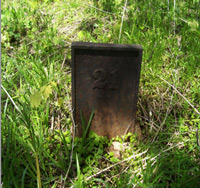I understand the need for privacy – especially as deals with medical information. But it seems to me that some common sense should have been written into our privacy laws in this country. But I suppose that’s asking too much…
And I still can’t understand why dead folks should have a right to privacy. We survived for hundreds of years in this country with case law pretty well establishing that they had none. And then – in my lifetime, that all changed. We can’t even find out who’s buried in the Willard Psychiatric Hospital Cemetery – and there’s 5700 human beings buried there!
The following excerpt is from an article posted July 3, 2011 at syracuse.com.
On Oct. 13, 1869, Willard Asylum’s first patient arrived at the state mental health facility in Seneca County [New York]. A steamboat dropped off Mary Rote, who had been confined in the Columbia County poorhouse for 10 years, much of the time nude and chained. Three men also arrived that day. All were in irons.
Thousands of patients eventually followed, many of whom spent the rest of their lives at the facility that became known in 1974 as Willard Psychiatric Center. One account reports that eight years after opening, 1,550 people were housed at Willard. Most of them “arrived by boat and left by hearse.”
About 58,000 people were treated at Willard before the state closed it in 1995. More than 5,700 patients were buried there. Some patients had no relatives to claim them; others were too ashamed to do so. The vast majority of the dead patients have only a number marking their final resting place. Many of the markers have been pulled out or are covered with grass.
A group called the Willard Cemetery Memorial Project hopes to clean up the cemetery and put up markers listing the patients buried there.
“Nobody should be in an unmarked grave,” said Colleen Kelly Spellacy, of Waterloo, who is leading the project.A burial record resides in New York State Archives in Albany. The group sought it under the state’s Freedom of Information Law. Its request was denied. State officials say they can’t release it because federal and state law require health care providers to ensure the privacy of patient records and health information. That confidentiality, they say, extends even after patients die.
The Willard group is appealing the FOIL decision. It could pursue a court order or legislation to force release of the names. Members have an uphill battle in persuading a judge or the Legislature that their desire for a memorial outweighs the state’s understanding of the obligation to protect patients’ confidentiality.
Other Important Links Dealing with the Willard Psychiatric Center:
The Willard Cemetery Memorial Project website.
Preliminary Guide to Mental Health Documentary Sources in New York State – An inventory of the holding of the New York State Archives dealing with New York mental health facilities. Willard is included in the inventory.
Photographs of the old abandoned Willard State Hospital buildings.
Various Articles about Willard Psychiatric Center – From the New York Times, Newsweek, USA Today, and the AP.
Photos from Joe Crispin’s Notebook.
The Willard Suitcase Exhibit Online – an article at the psychcentral website that includes some interesting comments at the end
A 1999 comment at Rootsweb about Willard Records and death certificates of patients.
Since the discovery of 400 long-abandoned suitcases at a former asylum, researchers have been piecing together the owners’ stories – an AP article by Michael Hill date 2001, and initially printed at the Newsday site – now found at Rootweb.
The Lives They Left Behind – a 2007 story published in the Southeast Missourian.
Willard Asylum Cemetery, Military Section, Seneca Co., NY – Pictures of Headstones.
Willard Asylum for the Chronic Insane – This is currently a short piece on the hospital found at Wikipedia.

Thank you for all this information. I have a great-grand uncle who was first in the State Asylum in Utica and then at Willard in the 1900 census. What you’ve provided in this post should answer many of the questions I have.